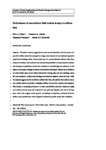Performance of non-uniform tidal turbine arrays in uniform flow
| dc.contributor.author | Bonar, PAJ | |
| dc.contributor.author | Adcock, Thomas | |
| dc.contributor.author | Venugopal, V | |
| dc.contributor.author | Borthwick, Alistair | |
| dc.date.accessioned | 2021-08-22T16:12:01Z | |
| dc.date.available | 2021-08-22T16:12:01Z | |
| dc.date.issued | 2018-08 | |
| dc.identifier.issn | 2198-6444 | |
| dc.identifier.issn | 2198-6452 | |
| dc.identifier.uri | http://hdl.handle.net/10026.1/17693 | |
| dc.description.abstract |
Theoretical models suggest that in order to maximise their collective power output, tidal turbines should be arranged in a single cross-stream row and optimally spaced to exploit local blockage effects. However, because it is assumed that the turbines within these arrays are identical, such models do not consider the possibility of enhanced power production through the exploitation of spanwise variations in local blockage and resistance. In this paper, we use depth-averaged numerical simulations to investigate whether the performance of a tidal turbine array can be further enhanced by varying solely the local blockage, solely the local resistance, or both local blockage and resistance together, across the array width. Our results suggest that for an initially uniform flow field, the optimal tidal turbine array is also uniform, that is to say that it comprises turbines of equal size, spacing, and resistance. This finding is encouraging because it is more cost-effective and much simpler to design each turbine to be the same and to operate in the same way. Together with earlier findings, these results also suggest a more general, and perhaps unsurprising, conclusion that tidal turbine arrays perform best when designed to match site-specific natural flow conditions. | |
| dc.format.extent | 231-241 | |
| dc.language | en | |
| dc.language.iso | en | |
| dc.publisher | Springer Science and Business Media LLC | |
| dc.subject | 7 Affordable and Clean Energy | |
| dc.title | Performance of non-uniform tidal turbine arrays in uniform flow | |
| dc.type | journal-article | |
| dc.type | Journal Article | |
| plymouth.issue | 3 | |
| plymouth.volume | 4 | |
| plymouth.publication-status | Published | |
| plymouth.journal | Journal of Ocean Engineering and Marine Energy | |
| dc.identifier.doi | 10.1007/s40722-018-0118-x | |
| plymouth.organisational-group | /Plymouth | |
| plymouth.organisational-group | /Plymouth/Faculty of Science and Engineering | |
| plymouth.organisational-group | /Plymouth/Faculty of Science and Engineering/School of Engineering, Computing and Mathematics | |
| plymouth.organisational-group | /Plymouth/Users by role | |
| plymouth.organisational-group | /Plymouth/Users by role/Academics | |
| dc.identifier.eissn | 2198-6452 | |
| dc.rights.embargoperiod | Not known | |
| rioxxterms.versionofrecord | 10.1007/s40722-018-0118-x | |
| rioxxterms.licenseref.uri | http://www.rioxx.net/licenses/all-rights-reserved | |
| rioxxterms.type | Journal Article/Review |


